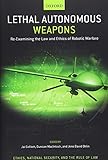Lethal Autonomous Weapons : Re-Examining the Law and Ethics of Robotic Warfare / edited by Jai Galliott, Duncan Maclntosh and Jens David Ohlin
Material type: TextSeries: The Oxford Series in Ethics, National Security, and the Rule of LawPublication details: New York Oxford University Press 2021Description: xi, 302p. : ill. ; 24cmISBN:
TextSeries: The Oxford Series in Ethics, National Security, and the Rule of LawPublication details: New York Oxford University Press 2021Description: xi, 302p. : ill. ; 24cmISBN: - 9780197546048
- 23rd Ed. 172.42 GAL
| Item type | Current library | Collection | Call number | Copy number | Status | Notes | Date due | Barcode | |
|---|---|---|---|---|---|---|---|---|---|
| Reference Book | VIT AP School of Law LAW Section | Reference | 172.42 GAL (Browse shelf(Opens below)) | LA01496 | Not for loan | Law | 019694 | ||
| Text Book | VIT AP School of Law LAW Section | 172.42 GAL (Browse shelf(Opens below)) | LA02167 | Available | Law | 021019 |
Browsing VIT AP School of Law shelves, Shelving location: LAW Section Close shelf browser (Hides shelf browser)

|

|

|

|

|

|

|
||
| 170 BLA Being Good : | 172.42 FIS Morality and War | 172.42 GAL Lethal Autonomous Weapons : | 172.42 GAL Lethal Autonomous Weapons : | 172.42 GRO Soft War | 172.42 HIM Drones and the Ethics of Targeted Killing / | 172.42 SOR The Ethics of War : |
It Includes Index Pages.
Description
The question of whether new rules or regulations are required to govern, restrict, or even prohibit the use of autonomous weapon systems has been the subject of debate for the better part of a decade. Despite the claims of advocacy groups, the way ahead remains unclear since the international community has yet to agree on a specific definition of Lethal Autonomous Weapon Systems and the great powers have largely refused to support an effective ban. In this vacuum, the public has been presented with a heavily one-sided view of Killer Robots.
This volume presents a more nuanced approach to autonomous weapon systems that recognizes the need to progress beyond a discourse framed by the Terminator and HAL 9000. Re-shaping the discussion around this emerging military innovation requires a new line of thought and a willingness to challenge the orthodoxy.
Lethal Autonomous Weapons focuses on exploring the moral and legal issues associated with the design, development and deployment of lethal autonomous weapons. In this volume, we bring together some of the most prominent academics and academic-practitioners in the lethal autonomous weapons space and seek to return some balance to the debate. As part of this effort, we recognize that society needs to invest in hard conversations that tackle the ethics, morality, and law of these new digital technologies and understand the human role in their creation and operation.
Table of Contents
Introduction
List of Contributors
The Case for Lethal Autonomous Weapons
Chapter One: Fire and Forget: A Moral Defense of the Use of Autonomous Weapons Systems in War and Peace
Duncan MacIntosh
Chapter Two: The Robot Dogs of War
Deane-Peter Baker
Chapter Three: Understanding AI & Autonomy: Problematizing the Meaningful Human Control Argument Against Killer Robots
Tim McFarland & Jai Galliott
Chapter Four: The Humanitarian Imperative For Minimally-Just AI In Weapons
Jason Scholz and Jai Galliott
Humans, Robots & Values
Chapter Five: Programming Precision? Requiring Robust Transparency for AWS
Steven J. Barela & Avery Plaw
Chapter Six: May Machines Take Lives to Save Lives? Human Perceptions of Autonomous Robots (with the Capacity to Kill)
Matthias Scheutz and Bertram F. Malle
Chapter Seven: The Better Instincts of Humanity: Humanitarian Arguments in Defense of International Arms Control
Natalia Jevglevskaja and Rain Liivoja
Chapter Eight: Toward a Positive Statement of Ethical Principles for Military AI
Jai Galliott
Chapter Nine: Empirical Data on Attitudes Towards Autonomous Systems
Jai Galliott, Bianca Baggiarini, Sean Rupka
The Rationality of Automaticity
Chapter Ten: The Automation of Authority: Discrepancies with Jus Ad Bellum Principles
Donovan Phillips
Chapter Eleven: Autonomous Weapons and the Future of Armed Conflict
Alex Leveringhaus
Chapter Twelve: Autonomous Weapons and Reactive Attitudes
Jens David Ohlin
Chapter Thirteen: Blind brains and moral machines: neuroscience and autonomous weapon systems
Nicholas G. Evans
Developing Meaningful Human Control
Chapter Fourteen: Enforced Transparency: A Solution to Autonomous Weapons as Potentially Uncontrollable Weapons Similar to Bioweapons
Armin Krishnan
Chapter 15: Normative Epistemology for Lethal Autonomous Weapons Systems
Kate Devitt
Chapter Sixteen: Proposing a regional normative framework for limiting the potential for unintentional or escalatory engagements with increasingly autonomous weapon systems.
Austin Wyatt and Jai Galliott
Chapter Seventeen: The Human Role in Autonomous Weapon Design and Deployment
M.L. Cummings
There are no comments on this title.

